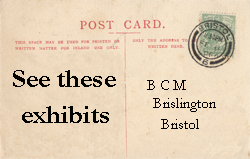Marshall, Keene & Co

The series of postcards by Marshall, Keene & Co. that depict the convent of Arno's Court come from a company that is well-known for turning private commissions from organisations such as schools and religious organisations into postcards that served as a showcase which could be used for publicity and/or fund-raising.
The company was founded in 1902 (Historic England) and the back of these postcards bear the credit: "Photographed and published by Marshall, Keene & Co., 24/25, Hart St., Holborn, W.C." This definitely dates this set of postcards to before the company moved to Hove, Sussex, in the 1920s.
The only catalogued postcard from this series that was posted has an indistinct postmark, but its halfpenny stamp from the reign of George V, couldn't have been used earlier than 1911, or later than 1918.
Their local postcards include:
Exterior of back buildings - Arno's Court, Bristol. See our exhibit.
Interior of the school room - Arno's Court, Bristol. See our exhibit.
Interior of the cloisters - Arno's Court, Bristol. See our exhibit.
Interior of the chapel. Arnos Court Bristol, The Chapel. Published online at Bristol Archives. The photograph was taken inside the chapel of what was (according to the 1911 Census) the "Reformatory School for Girls, Arno's Court", and is now part of Arnos Manor Hotel. The chapel was partially demolished to allow an expansion of the A4 Bath Road. One wall remains standing to provide enclosure on all sides of the cloister. Given that the altar is at the eastern end of the chapel, the wall on the right-hand side of the picture is the one visible from the road. The ornate column shown in the photograph as supporting the arch that separates the nave from the chancel, is still in place although now it's an exterior feature.
View of the convent and grounds - Arno's Court, Bristol. See our exhibit.
The pool in the grounds - Arno's Court, Bristol. See our exhibit.
The woods on the hill - Arno's Court, Bristol. See our exhibit.
Some notes
It's thought that the first two digits of the reference numbers on the postcards signify the year in which they were printed (Rendel Williams), which suggests these were printed in 1913. The second set of digits are, in the case of these postcards at least, separated by four, which perhaps was to allow for up to three reprints of various sorts (so far as is known, no variants were published).
These monochrome postcards were printed in Saxony using a collotype process (at that time the Continent was renowned for high quality collotype printing). The outbreak of the World War in 1914 stopped most British companies from employing printers from any part of the German Empire (including Saxony), which tallies with the date proposed for the reference numbers.
Bibliography
Historic England 2022, Marshall, Keene and Company Collection, London, Historic England, https://historicengland.org.uk/images-books/archive/collections/photographs/marshall-keene-and-company/ (accessed 15 Apr 2022).
Rendel Williams 2013, Marshall, Keene & Co., Sussex Postcards, http://www.sussexpostcards.info/publishers.php?PubID=187 (accessed 15 Apr 2022).